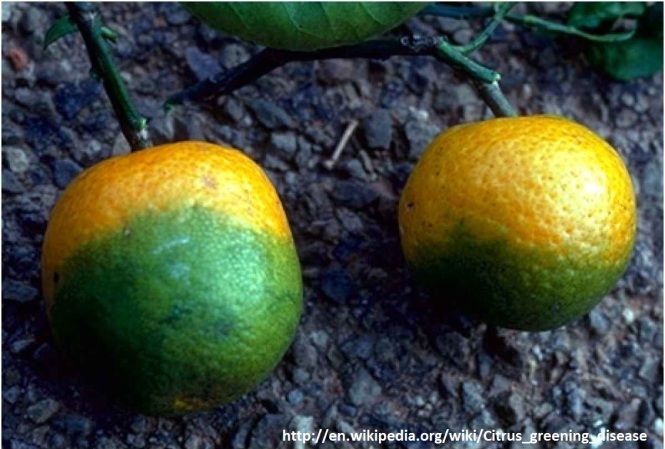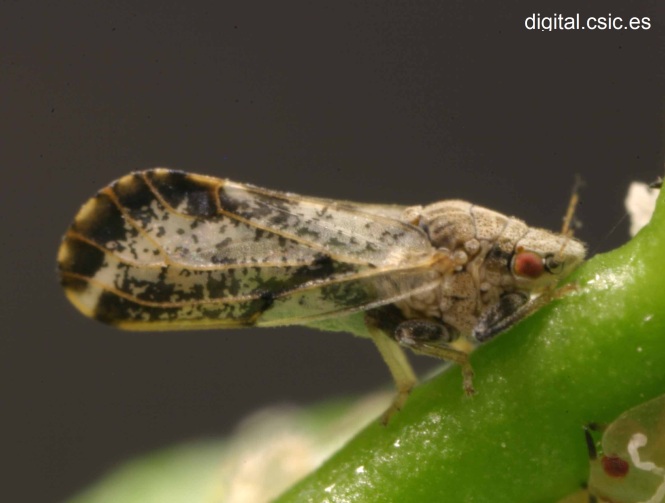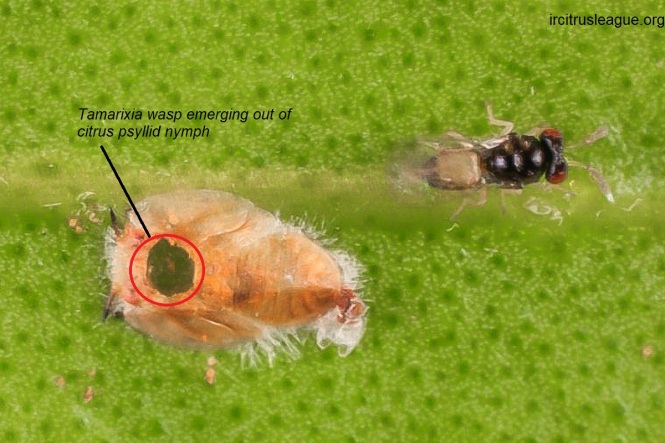Introduction:
Huanglongbing of citrus is one of the most destructive disease of citrus fruits worldwide. Known with different names in different regions of the world, they cause a huge economic loss on part of citrus producers of the world. “Yellow shoot disease” in China, “likubin” (citrus decline) in Taiwan, “dieback” in India, “leaf mottle yellow” in the Philippines, “vein phloem degeneration” in Indonesia and “yellow branch”, “blotchy-mottle” or “citrus greening” in South Africa are the commonly referred names of Huanglongbing (HLB) of citrus. This devastating disease has been known to be caused by a gram negative bacterium “Candidatus Liberibacter” and vectored by psyllids.
Disease symptoms:
- Sectored or whole yellowing symptoms
- asymmetrical blotchy appearance
- Fruit deformation (shape, size)
- Color inversion
- Bitter taste
Fig: Sectored yellow appearance
Fig: asymmetrical blotchy appearance on leaves
Fig: Fruit showing symptom of HLB inside fruit
Fig: Typical color inversion symptom of HLB of citrus
Economic Impact:
The effect of HLB on citrus production and economy can be assessed in three primary ways:
- Increase in mortality rates of infected trees,
- Reduction of marketable yield per tree and
- Increased cost of production
The trees infected with pathogen becomes unproductive in 2-4 years of disease incidence. Low production coupled with production of poor quality fruits make loss estimate of 30-100%.
Causal Agent:
The pathogen causing HLB of citrus is a phloem sieve tube restricted gram negative bacteria “Candidatus Liberibacter” which has three forms or species;
- Candidatus Liberibacter asiaticus (originated in Asia)- Heat tolerant form
- Candidatus Liberibacter africanus (originated in Africa)- Heat sensitive form
- Candidatus Liberibacter americanus (recently discovered in the Americas)- Heat tolerant form similar to Asian form
A peculiar characteristic of this pathogen is its inability to be cultured in an artificial medium. Pertaining to this special characteristic, it has been classified under genus “Candidatus”
Vectors:
Disease has been found to spread over Asia and the America. Within a region, disease spread may be due to short distance transmission of the pathogen by the vector. Over large areas, disease spread occurs through movement of infected plant materials. When an infected plant material is transferred to a new healthy area, the pathogen get chance to transmit to newer plants and the disease spreads.
The Asian form of the pathogen is transmitted by Asian citrus psyllid; Diaphorina citri while the African form of the pathogen is transmitted by the African citrus psyllid; Trioza erytrea.
Fig: Asian citrus psyllid; Diaphorina citri
Fig: African citrus psyllid; Trioza erytreae
Disease Management:
Management of HLB of citrus is cumbersome. No any cure has been found till date. However, several management practices can reduce the disease severity and help to reduce the loss caused by this disease.
Three tiered management program of HLB has been recommended;
- Maintaining the vector population (Vector Management)
- Regular monitoring (for reducing inoculum)
- Use of disease free planting material (reducing inoculum)
However recently, a fourth tier is being evaluated to minimize the loss. Foliar nutrition strategy is being used by several growers of Florida and California to reduce the effect of pathogen over the tree and reduce the amount of crop loss.
- Limiting the movement: Movement of infected plant material can transmit the pathogen from an area to a healthy area. In order to limit the spread of this disease, movement of infected material, the vector and the pathogen must be monitored. Several federal and state quarantine laws have been implemented to restrict the movement of potential infection sources.
2. Scouting: Scouting is one of the epidemiological approach in disease management. Searching trees that might be a potential source of inoculum, marking them followed by their removal and destruction is the process of scouting. Scouting can be effective to reduce disease if done at correct time in a correct method. Scouting for infected trees should be done during fall and winter months. A team of specialists can walk through orchards or ride on an all-terrain vehicle (ATV) or an elevated platform searching for the potential source of inoculum. Whenever trees are suspected for disease, they need to be marked and subjected to destruction.
3. Managing the Pathogen:
3.1 Heat-therapy: Heat treatment is not a cure to this disease. But it has been found that even though the pathogen has heat tolerant forms, it is susceptible to heat of about 107 degree fahrenheit whereas citrus trees can handle higher temperatures for short periods.
In Florida, Short steam blasts are used to treat the suspected trees. Alternative to heavy-duty steam blasts are the plastic tents.
Fig: Short steam blasts
Fig: Plastic tents
3.2 Antibiotics: The pathogen is sensitive to antibiotics. Antibiotics can be injected into the infected trees through tree injector. Tetracycline hydrochloride was used as tree injections and showed good control over the pathogen. But it was found to have phytotoxic effect. N-pyrrolidinomethyl tetracycline provides a better control. High cost of management and potential of the pathogen to re-infect may be a drawback in using it.
4. Managing the vector:
4.1 Use of insecticides: A combination of two kinds of insecticides can help to manage the vector.
- Foliar pyrethroids to quickly kill adults and immature pyrethroids
- systemic insecticides applied as ground drench to control nymphs
Vector management through combination of these two kinds of insecticides is believed to be effective for 9-12 months.
4.2 Biological control: One of the environmentally friendly way of managing the vector might be through the use of its natural enemies. Natural enemies to the psyllid are Lady beetles, syrphid flies, Lacewings, spiders etc.
4.3 Entomopathogens:
Fig: Hirsutella citriformis
Fig: Isaria fumosorosea
4.4 Use of parasitoids:
Fig: Tamarixia radiata
Fig: Diaphorencyrtus aligarhensis
For more details: POUDEL 655 #Term Paper 2015 HLB of Citrus














I cultivate a some tree of cutris or leemon their leaves yellow and and not growth
Plz any madisn spray?